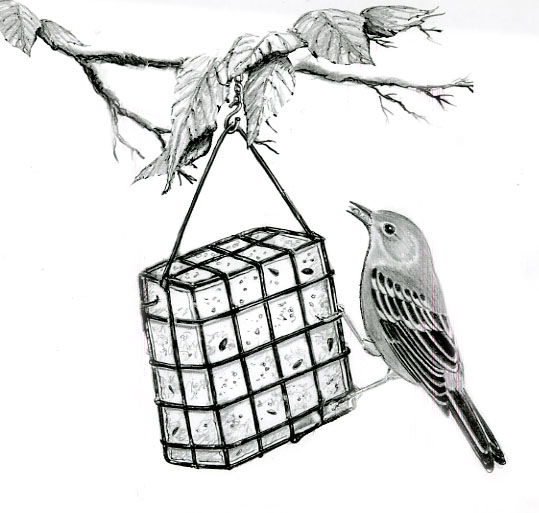
Dear Bird Folks,
Lately we have been getting tons of goldfinches on our thistle feeder, but this winter we only had one. A lone female finch would occasionally come to our yard, but instead of eating thistle she would pick at our suet feeder. Why was she alone and not traveling with a flock as goldfinches usually do? Were the other finches upset with her because she was eating suet instead of seeds?
– Mark, Wellfleet, MA
That’s right, Mark,
All the other goldfinches boycotted that one female finch because she stepped over the seed-lovers line and ate meat. Goldfinches are mostly vegetarians and because of that the others wouldn’t allow themselves to be seen with a barbaric carnivore. And I don’t blame them. I mean really, who wants to flock around with some bird that has meat-breath? Talk about a turn off. However, there’s a high probability that the bird you saw wasn’t even a finch at all. I think your female “goldfinch” was a Pine Warbler, which is a meat-eater, posing as a finch. Tricky, eh? That’s why you should never trust a meat-eater, even in the bird world.
The olive-yellow Pine Warbler does look a bit like a female goldfinch, but the warbler’s thin, needle-like bill suggests that it’s not a finch. (Finches, which have no use for those skinny warbler beaks, have chunky, cone-shaped bills that they use to bust open tough seeds.) Pine Warblers have the little known distinction of being the only warbler that can be found on Cape Cod anytime of year. Pine Warblers like it here because we have lots of their favorite trees. I’m not sure what those trees are, but I can check. Hang on a second while I go look it up. (While I’m gone imagine me flipping through stacks of complicated textbooks.) Okay, I’m back. The trees that Pine Warblers like so much are pine trees. Whoa! I would never have guessed that one. It’s a good thing I looked it up.
Pine Warblers are so into pine trees that they are not often found away from them, except possibly during migration. They eat, sleep, nest and watch TV all in pine trees. Cape Cod, especially the Outer Cape, has it’s share of those funky trees called “Pitch Pines” (you know, those trees that like to drip their sap on our cars). Because of that we have a healthy population of pine-loving warblers. Pine Warblers are not your average warbler, though because they rarely travel south of the U.S. That’s unusual. During the winter most warblers escape and hide out in the tropics, but this little bird never leaves us. The tropics may have delicious coffee and happy monkeys, but we have the best pine trees, which are all the Pine Warblers need.
Pine Warblers, like all warblers, are big time insect eaters. Right now you are wondering (and even if you aren’t wondering, just play along): “How can they survive in the winter without a steady supply of bugs? Good question. I’m glad you asked. They survive by eating from suet feeders, just like yours, Mark. They will also grab seeds from birdfeeders, which is a rare thing for a warbler to do. And if there aren’t any feeders handy, they will pick seeds from their favorite trees, the pines. However, eating seeds isn’t a simple task for a bird that is born with a skinny beak that’s built for plucking tiny insects off branches. To make up for this limitation Pine Warblers have taken a page out of the nuthatch’s playbook. They get into the seeds by jamming them into tree crevices and hammering them open. Many people are surprised when they learn about this behavior, but what they really should be surprised to learn is that nuthatches have a “playbook.” Not many folks know that.
I can see how you could confuse Pine Warblers and female goldfinches, Mark. I’ve heard it before. But seeing a goldfinch eating suet would be a rare event. They just aren’t into the animal protein scene. The American Goldfinch prides itself on being a fairly strict seedeater. That’s not to say they won’t grab a bug every now and then, but that mostly occurs when an insect simply happens to be in the way or when no one else is looking.
While we are on the topic of goldfinches I’d like to take this opportunity to calm a few fears. Right now (mid-June) most people are seeing flocks of colorful finches on their feeders, but many of the other “feeder birds” (chickadees, nuthatches, cardinals, titmouses, etc.) are less common. Why? It’s because we are smack in the middle of baby bird season. With the exception of goldfinches, which haven’t begun to nest yet, parent birds are busy jamming worms, caterpillars and other insects into the mouths of their yapping kids. Because birds are busy gathering bugs they are less interested in our feeders. During this time we sell less birdseed and hear from lots of people wondering, “what’s happened to the birds?” Anyone seeing fewer birds should just take a deep breath and relax. Soon after the babies start flying you’ll once again have tons of birds at your feeders. At that point my customers will do two things: they’ll resume buying seed and they’ll resume complaining about the prices. That’s when I know everything is back to normal.